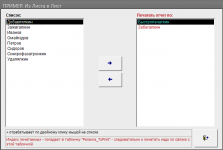D
Deleted member 73419
Guest
Hi,
I'm struggling with moving items between listboxes on a form.
Currently, I have this arrangement:

There are two listboxes, lstLeft & lstRight, a textbox under lstLeft called txtSearch and four buttons, cmdMoveAllRight, cmdMoveRight, cmdMoveLeft and cmdMoveAllLeft, from top to bottom.
lstLeft contains a lot of records (approx 70k) from a table so I populate it with this code when the form opens:
The end goal is to have the buttons move data between listboxes and the search textbox to limit the contents of lstLeft to a manageable range dynamically as you type.
The trouble I'm having is how do you move data between the listboxes? For example when I want to move from lstLeft to lstRight - if I were to iterate through the selected items in lstLeft and then add them to lstRight, I need Row Source Type of lstRight to be set to Value List but I cannot use this method to move from lstRight to lstLeft as the Row Source Type for lstLeft is Table/Query in order to populate from a table when the form opens.
I also need to be able to remove the items I've just moved from one listbox as I'm adding them to the other. As far as I know you cannot remove items from a listbox where the Row Source Type is set to Table/Query...
Is there an easy way to do this?
Thanks
I'm struggling with moving items between listboxes on a form.
Currently, I have this arrangement:
There are two listboxes, lstLeft & lstRight, a textbox under lstLeft called txtSearch and four buttons, cmdMoveAllRight, cmdMoveRight, cmdMoveLeft and cmdMoveAllLeft, from top to bottom.
lstLeft contains a lot of records (approx 70k) from a table so I populate it with this code when the form opens:
Code:
lstLeft.RowSource = "SELECT Part, Desc FROM Parts ORDER BY Part ASC"
lstLeft.ColumnCount = 2
lstLeft.ColumnWidths = ";;60"The end goal is to have the buttons move data between listboxes and the search textbox to limit the contents of lstLeft to a manageable range dynamically as you type.
The trouble I'm having is how do you move data between the listboxes? For example when I want to move from lstLeft to lstRight - if I were to iterate through the selected items in lstLeft and then add them to lstRight, I need Row Source Type of lstRight to be set to Value List but I cannot use this method to move from lstRight to lstLeft as the Row Source Type for lstLeft is Table/Query in order to populate from a table when the form opens.
I also need to be able to remove the items I've just moved from one listbox as I'm adding them to the other. As far as I know you cannot remove items from a listbox where the Row Source Type is set to Table/Query...
Is there an easy way to do this?
Thanks


